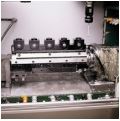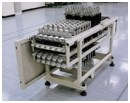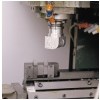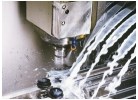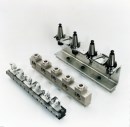Under Control
This small-parts machining operation combines superbly automated workholding and handling with total machining process management.
Share




While there is no such thing as a perfect production process, some manufacturers strive mightily to achieve that ideal. A good case in point can be found near Wotton-under-Edge in Gloucestershire, England, where metrology systems maker Renishaw plc machines the mechanical parts for its well-known CMM and machine tool probes.
What you first see when you walk around the spotless shop are 13 relatively low-cost vertical machining centers, each fitted with an identical rig of workpiece handling automation. It all appears uncomplicated and uniform. But what appears simple from the outside is in fact the result of an extremely sophisticated rationalization of the machining process. There simply is a whole lot more going on here than meets the eye.
Attached to each VMC is a portable, 50-station carousel from which workpieces and tooling are shuttled in and out of the machines. The carousels permit the machine tools to remain in unattended operation for more than a day at a time. But it takes much more than automatic loading to make sure that unattended machines make good parts. So an extraordinary level of process engineering has come into play that begins with product design and ends on machines with the capability to dimensionally check their own work—or more precisely, to check their own dimensional health so that they can machine unattended to tolerances as small as 10 microns.
The production system as a whole is referred to as RAMTIC, for "Renishaw's Automated Milling, Turning and Inspection Center." While that sounds like a lot to accomplish on inexpensive VMCs, they do it every day at Renishaw. Here are some of the secrets behind the simplicity.
Better Fixturing
To appreciate how far this operation has come, it helps to look back to where it began. For the sake of clarity, we'll start at the machine tool and then work back into process engineering.
According to manufacturing development manager Mark Buckingham, Renishaw's Advanced Machining Project began 10 years ago to develop a "cost effective, unattended, `right first time' manufacturing system capable of maintaining the quality of the machined component to a traceable standard." Most of that is self-explanatory enough for now. The "traceable standard" part means a measuring and calibration process that can be traced back to a known standard of accuracy.
Prior to the advanced machining initiative, the shop did a lot of machining from billets. While it was simple, it was not very productive. Many of the parts required multiple setups, some requiring turning and milling operations, and all by Mr. Buckingham's reckoning gave up too much time to part changing and tool changing. Then the shop tried moving the round parts off of machining centers and on to sophisticated turn/mill machines. While that approach offered some advantages—most importantly, the ability to machine more features in a single setup—it was expensive from a capital standpoint, and less efficient than anticipated. The problem was that, even though many parts were round, as much as 80 percent of the machining involved milling and drilling processes, and the lathes weren't sufficiently robust in their rotating-tool capabilities.
Then Renishaw's engineers came up with several process innovations to overcome the limitations of both prior methods. For one, they developed a fixturing method that allows three sides each of multiple parts to be machined in a single setup on a vertical machining center. At the heart of the system are simple pallets cut to length from aluminum extrusions. Each pallet has a dovetail form running the length of its base that provides both a location reference and clamping surfaces for a pallet receiver on the machine tool. According to Renishaw, the system can be adapted as a flexible platform for various simple fixtures machined into the extrusion or as a "sacrificial billet," where components are machined directly from the extrusion and then removed with breakout tabs.
On the machine tool, three pallet receivers are mounted on a triangular base held horizontally between centers on a high speed indexing system. Thus, three sides of parts held on three separate pallets can be machined in a single setup.
Next Step, Automation
Multi-part fixturing alone brought a great deal of efficiency to the machining process. With fewer setups as well as far fewer tool and part changes, average total cycle times were more than cut in half. But at this stage, machinists still had to do first-off inspections and then update their tool offsets manually. While this method required a greater amount of operator interaction than desired, Renishaw's engineers made fruitful use of this phase of the project to gain a detailed understanding of the basic machining process capabilities. They studied which tools and cutting strategies were the most accurate and efficient. And then they began to link the best machining processes with product design features—a critical process control—which we'll get to a little later.
Once a firm understanding of the machining process was established, it became possible to move to a much higher level of automation. Given the standardized workholding arrangement, it was readymade for automatic loading and unloading of the dovetail pallets, and thus the pallet storage system was born. Capable of handling 50 pallets on an indexing carousel chain, the whole workpiece handling unit is self-contained, portable, and interchangeable among each of the shop's 13 appropriately fitted VMCs. Loaded off-line, the carousel is simply rolled to the machine tool, "plugged in" and run. An air actuated transfer arm slides the pallet from the carousel through an aperture in the machine's guarding and onto the periphery of the pallet receiver where it is clamped automatically.
But the carousel serves a much larger purpose then loading workpieces. It is, in fact, a master kitting station for both the machining process and for subsequent assembly operations. For the latter purpose, one carousel typically has all the eight-to-ten machined parts required to make a specific probe assembly. So, once a lot is machined, an equal number of kits of all parts are ready for the next phase of the manufacturing process. A full carousel of parts is usually machined at a time—typically more than 24 hours' worth of production—so in a sense, Renishaw has economic order quantities, whatever fills a carousel. But they only run carousels as needed, with the schedule driven by the company's MRP system. It is, as Mr. Buckingham puts it, a fixed quantity, variable frequency system.
One disadvantage of running such a variety parts at one time, however, was that it outstripped the tooling capacity of the machines. And so the carousels' role was expanded to carry tools as well. A simple modification to the basic dovetail pallet allowed it to support several spindle tools. The tools are introduced to the machine tool using the same transfer system as the components. The machine's spindle is then used to pick up new tools and deliver used tools back to the carousel automatically under program control.
If you're wonder what happened to those turning operations, the RAMTIC system allows them to be executed right on the VMC. In these cases, the workpieces are mounted on 40-taper shanks, which are then carried into the machine tool and inserted into the spindle, just like other toolholders. A fixed turning tool block, then, is mounted on the table of the VMC, and the spindle is brought to the tools for turning and boring operations. Utilizing the spindle's 10,000-rpm capability in this manner, high quality finishes are achieved with very short cycle times.
This is not to say that each part on a carousel is produced complete in each cycle. Some parts still require more than one setup—these turned parts, for example. In these cases, parts move from station to station within a carousel, much like a transfer process. But each time a full carousel of parts is completed, a matched set of finished parts comes off the machine. Once a fully-cycled carousel is pulled from the machine, all finished parts are unloaded, in-process parts are refixtured and moved to the next station, and first operation stations are replenished with raw stock for the next cycle. If that sounds like a time-consuming task, remember that it is all done external to the setup. And given that a carousel runs for at least a day, there is plenty of time to prepare for the next cycle.
A Healthy Process
But there's much more to unattended machining than just automatically manipulating workpieces and tooling. If Renishaw was to hold such demanding tolerances, they knew that a number of process checks had to be engineered to compensate for the inherent variably of machine tools as they cycle throughout the day, and for tooling that always must be offset to some degree. As you might expect from Renishaw, on-machine probing plays a significant role here, but probably not in the way you expect.
This process begins all the way back in CAD, where design tolerances are established using a technique called "gage point analysis," which pays dividends in a number of ways. Unfortunately, we can't give this discipline its due here—indeed, Mr. Buckingham could write a book on it. But the short of it is that critical tolerances are defined only in terms of specific reference points on the surface of the part model and allowable deviations from those points—information that is coded into a solid model of the part. For inspection purposes, Renishaw has developed a generative processor in conjunction with CAD/CAM developer Unigraphics Solutions that can scrutinize the solid model, find the gage points, and then automatically create an inspection program.
That's much more than a handy timesaver when you look at how the inspection methodology integrates with the machining process. Gage points are selected in such a way that each point tolerance corresponds directly with a one- or two-dimensional cutter compensation value for the tool that generates that specific workpiece feature. Moreover, each tool in a process has a corresponding gage point. That means that the gage points of a machined part can be inspected with a spindle-mounted probe, the results can be compared to target values, and then tool compensation values can be automatically calculated and entered directly into the tool offset register—all with a relatively simple CNC resident macro.
Taking Its Temperature
Of course, many people are uncomfortable with a machine tool checking its own work, figuring that any motion control errors will be replicated in machining and probing routines alike. This is one reason why Renishaw insists that the measuring discipline be traceable to a known standard and why the company takes such care in continuously monitoring the accuracy health of the machine.
Most of this is done with the strategic use of artifacts, of which Renishaw uses two types—a general-purpose machine tool calibration block and a workpiece replica. In either case, the principle is the same. The artifact is a master component of known dimension and the same thermal expansion properties as the material to be machined. In Renishaw's case, artifacts are measured under temperature-controlled conditions on an extremely precise CMM, which itself is finely calibrated to a traceable standard. Thus, the artifact becomes a reliable dimensional benchmark for the machining process at hand.
The general-purpose artifact is just a collection of features—bores, bosses and slots. The artifact is loaded into the machine, measured by a spindle-mounted probe with a general inspection routine, and then the results are compared to the base values to provide a detailed picture of the accuracy of the machine. This way, error values of the machine in its current state can be calculated and factored into all subsequent motion control commands and measurement results. Thus the accuracy of the system now becomes determined by the artifact rather than having to rely solely on the accuracy of the feedback mechanism of the machine tool.
According to Mr. Buckingham, just by using a general artifact to calibrate the machining and probing system, Renishaw can hold tolerances of 20 microns on a production basis. If tolerances are tighter, workpiece artifacts are required. Workpiece artifacts serve essentially the same function as a general artifact, but are configured very similarly to the actual workpiece, allowing even tighter calibration of the machining process. With this technique, production tolerances as small as 10 microns can be achieved. That's approaching the inherent repeatability capability of the machine.
But let us not leave the impression that lots of valuable production time is given up to probing. Renishaw conducts a general artifact check about once a day, or more precisely, each time a new carousel is loaded onto the machine. Workpiece artifacts are seldom required at all. And once machining processes are stabilized, which typically happens very early in a cycle, relatively little workpiece probing is required either.
Good Process Design
Reducing the need for inspection is directly related to designing high quality and repeatable processes from the start, and it is here where Renishaw does some of its best work. The company's engineers have taken great care to tie part features and tolerances to the machining process required to meet an acceptable quality standard. In the early stages of the advanced machining project, this exercise was a good means for helping design engineers better appreciate the cost and manufacturing quality implications of their specifications.
In time, however, the discipline has become much more formalized in a feature-based design and manufacturing planning system. In essence, the system consists of a standardized library of part features, each of which is tied to a proven machining process of known statistical capability. Aided by this tool, new products are developed with up-front knowledge of manufacturability. Indeed, as long as designers stay with features in the library, new products can flow into manufacturing with virtually no new process engineering to be done and no surprises on the shop floor. Renishaw's management feels so strongly about the benefits of this discipline that, now, any new design deviations from the existing feature/process library require a high-level approval within the company.
But has all this engineering work really been worth it? There's little doubt of that at Renishaw, with the answer being an unequivocal yes. What matters most to this company is floor-to-floor time and the number of value-added hours of machining time they are able to achieve each week. And by those measures, the performance of RAMTIC has been spectacular. Mr. Buckingham figures that in comparison to the old process, average output has increased 2.3 times per machine and that the company gets 130 hours of production per machine per week. That has provided Renishaw a much higher density of output per square meter of floor space, and dramatically cut in-process material handling requirements and inventory as well.
Indeed, the project has been so successful that all new products will be machined in this manner. At this writing, Renishaw is in the process of putting in five more RAMTIC production centers, though the new machines have much higher speed capabilities of 25,000 rpm. These more capable machines, of course, will necessitate more serious process engineering. But we suspect it too will be well worth the investment.
Related Content
Turning Fixed-Body Plug Gages Inside Out
Fixed-body mechanical plug gages provide fast, high-performance measurement for tight-tolerance holes.
Read MoreProcess Control — Leveraging Machine Shop Connectivity in Real Time
Renishaw Central, the company’s new end-to-end process control software, offers a new methodology for producing families of parts through actionable data.
Read MoreHelp Operators Understand Sizing Adjustments
Even when CNCs are equipped with automatic post-process gaging systems, there are always a few important adjustments that must be done manually. Don’t take operators understanding these adjustments for granted.
Read MoreThe Link Between CNC Process Control and Powertrain Warranties
Ever since inventing the touch-trigger probe in 1972, Sir David McMurtry and his company Renishaw have been focused on achieving process control over its own manufacturing operations. That journey has had sweeping consequences for manufacturing at large.
Read MoreRead Next
Building Out a Foundation for Student Machinists
Autodesk and Haas have teamed up to produce an introductory course for students that covers the basics of CAD, CAM and CNC while providing them with a portfolio part.
Read MoreSetting Up the Building Blocks for a Digital Factory
Woodward Inc. spent over a year developing an API to connect machines to its digital factory. Caron Engineering’s MiConnect has cut most of this process while also granting the shop greater access to machine information.
Read More5 Rules of Thumb for Buying CNC Machine Tools
Use these tips to carefully plan your machine tool purchases and to avoid regretting your decision later.
Read More













